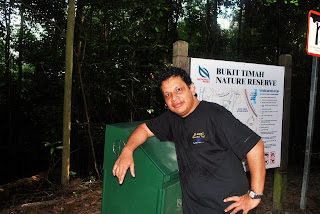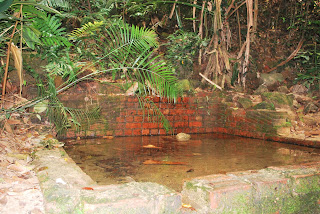Here is the information I gathered at the site. Hope it would be educational and useful for you. It is also for general knowledge.
Colugos
Colugos are arboreal gliding mammals found in South East Asia. They are tree - dwelling mammals. They have short, soft grey or reddish brown, mottled with black & white markings. This provides excellent camourflage against the tree trunks and allows them to escape the attention of most visitors to the reserve.
The Colugos is strictly tree dwelling. It moves from higher to lower branches in the forest by gliding, aided by a membrane called the patagium which connects the neck, flour limbs and the tail spreads out like a parachute.
Growing to the size of a cat, the Colugo feeds on leaves. flower buds and fruits. Like many rainforest species, they are endangered by the loss of the habitat due to deforestation in South East Asia.
Painted Wings
Butterflies and moths belong to the same order of insects, called Lepidoptera. The name means "scaly wings" as most butterflies and moths are covered with tiny overlapping scales. The scales not only protect & strengthen their wings but also from attractive colours & patterns
Butterflies
- Generally active during the day
- Most are brightly coloured
- Usually rest with their wings closed
- Bodies usually slender and not hairy
- Antennae has a dubbed tip.
Moths
- Generally active at night
- Most are dull in colour
- Usually rest with their wings open
- Bodies usually bulky and hairy
- Antennae is usually feather light
Surving the Goom
Under the forest canopy, only one to five percent of available light reach the forest floor. Ferns, palms and other herbaceous plants thrive here. They adapt to the low light and damp environment through their dark green leaves which efficiently gather sun flecks.
Then, you also have many thin saplings of large forest trees with few leaves, which may be astonishing 20-year-old trees. Deprived of sunlight, they are unable to grow to their potential as magnificant trees. All they need is an opening in the canopy, created when an old tree or a branch falls. This opening allows sunlight to penetrate to the forest floor, giving the many saplings a chance to race up to the canopy.
Let Hissing Snakes Lie
Snakes have been around for about 12o million years and are perhaps one of the most misunderstood animals.
Snakes play an important role in nature. Snakes such as python, performs a free pest control service by gobbling up rats. Some snakes even feed on other snakes. Many of the snakes constitute a natural resource with culinary, medicinal and ornamental value.
Of 75 species of snakes found in Singapore, about 28 species ( 39% ) are found in reserves.
Insects
Insects are unvertebrates, which means they do not have a back bone, unlike birds, reptiles and mammals. They have three pains of legs and most adult insects have one or two pairs of wings
Insects are the most successful animals on Earth. They make up three - quarters of all animal species in the world.
Insects perform a vital role in decomposition, flower pollination, plant protection & they act as an important food source for many animals.
What's So Special about the Bukit Timah Nature Reserve Rainforest
Less then 200 years ago, Singapore was still an island covered mostly with luxuriant lowland topical evergreen forest. Today, you can catch a glimpse of what the original vegetation looked like back then at Bukit Timah Nature Reserve.
The reserve continues to support an amazing diversity of species. Many treasures still await discovery. A recent survey produced a checkist of about a thousand species of plants & 250 species of animals, many of which can only be found in the reserve.
Stately Seraya
They are amongst the largest trees in this forest and the most common of the dipterocarps. Easily recognised by its characteristic fissures on the bark, it has shuttlecock like fruits than can travel great distances when carried by the wind.
It fruits every five to ten years after a severe drought. Its timber is commercially known as dark red meranti.
Mimic Kins
Darting around in the forest canopy is one of the most conspicuous birds in the nature reserve.
It has black plumage, red eyes, with eye-catching rackets at the end of the elongated shafts of its outer tail feathers.
It is superb at mimicking the calls of other birds in the forest, and is often spotted in group of two to four, following monkeys & squirrels, feeding on the insects they disturb.
From The Forest To Our Homes
Rattans are versatile which are used for a wide of purposes by people. About 20 species of rattan are traded commercially. Large canes are used for making furniture, while smaller sized canes are used for binding and weaving.
Rattan harvesting is a tedious job, as it involves the dragging down of the spines and leaves. The stem is then cut into manageable length, tied up in bundles and transported to the process site. Rattan canes must be treated to prolong the strength of the cane. Large sized canes are boiled in diesal or palm oil, cleansed with rags or sand and stacked upright in the sun to dry. The smaller canes are laid out on racks to dry imnmediately after collection.
Terap
This species is related the Jackfruit and Chempedak. This mature tree has entire leaves which differ from the larger and lobed leaves of the sapling stage. At times, one may even find lobed, entire, and semi-lobed leaves all in one tree.
The tough bark that strips readily in big streets is used for lining baskets, making house walls and strings.
Nature Takes Time To Heal
The forest goes through cycles of change. When a tree dies and falls of old age, disease or lightning strike, many other plants compete to take its place. In nature the regeneration processes function as a repair process following disturbance.
On thing is certain, forests round the world are being destroyed for its timber at a faster rate than it can recover. Research has shown that full regeneration of a forest can take up 800 years or even longer if the disturbance is severe.
Vines & Lianas
Climbing plants, unlike trees, cannot stand up on their own. They begin life on the ground & stretch to the canopy for light.
A variety of adaptations such as tendrilos, thorns, adventitous roots and twining stems help them climb. They take nothing from their host except support.
Screw Pines
The twisted shape of the trunks, and branches terminating in a rosette of ong strap-like leaves give these trees ( not true palms ) a distinctive appearance. Woven fibres from pandanus leaves are traditionally used to make baskets, mats and strings
The better known pandanus is P.cimaryllifolus which is used in Asian cooking because of its fragrant leaves.
Petaling
This tree lands its name to Kuala Lumpur's twin - town, Petaling Jaya. Shallow depressions are found in the surface of the trunk after the dead bark is shed.
It is a well-known timber tree which producers hard and durable timber used as poles in construction.
I leave you now with the pictures for your perusal. Starting of with this monkey that decided to pose for me. Makes me wonder, did GOD create the world or is it evolution. I will leave this debate to another entry. In the mean time take care and Carpe Diem.










































































































